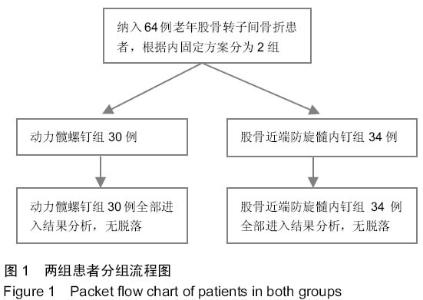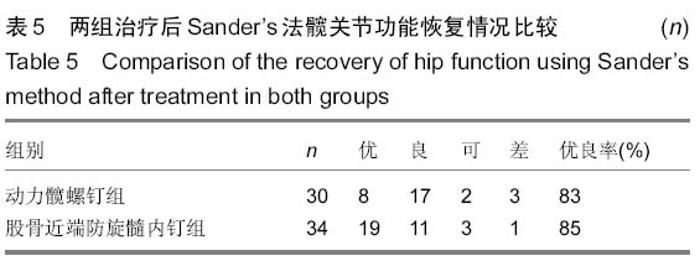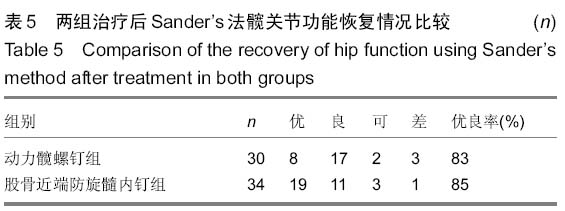| [1] Baxter JA,Krkovi M,Prakash U.Intertrochanteric femoralfractureafter hip resurfacing managed with a reverse distal femorallockingplate:A case report.Hip Int. 2010;20(4):562-564.
[2] WiltfongRE,Taylor BC,Steensen RN.Lower extremity bypass graftocclusion after intramedullary fixation of intertrochanteric hipfractureon afracturetable. Orthopedics. 2011; 34(5):395.
[3] 段文江,吴字,赵红军,等. PFNA与DHS治疗老年股骨粗隆间骨折的疗效比较[J].创伤骨科杂志,2013,15(1):41-44.
[4] TyuiaIlianakis M,Panagopoulos A.treatm ent of extracap-sular hip fractures witll the proximal femoral naj1(PFN):long termrosults in 45 patients. Acta Orthop Belg. 2009;70(5): 444-454.
[5] 文良元,许多良,蔡恒江,等.骨质疏松与老年髋部骨折[J].中华骨科杂志,2010,22(9):542-545.
[6] 曹磊,纪方.股骨粗隆间骨折治疗方法进展[J].中国矫形外科杂志, 2008,16(4):276-278.
[7] Liang J,Cao HB,Xin JY. Therapeutic eiiieacies of bone grating forcaleaneal intra-calcaneal Fractures. Zhonghua Yixue Zazhi. 2012;92(3):197-199.
[8] Woratanarat P,Kijkunastian C,Wajanavisit W,et al. Acomparative study of risk factors of femoral neck and in-tertrochanteric fracture in Thai men. J Med Assoc Thal. 2009;92(6): 165-171.
[9] 肖耀广.股骨近端解剖钢板内固定术后髋内翻原因分析[J].中国矫形外科杂志,2006,14(8):633-637.
[10] Tarantino U,Oliva F,Impagliazzo A,et al.A comparative prospectivestudy of dynamic variable angle hip screw and gamma nail inintertrochanterie hip fractures.Disabil Rehabil. 2005;27(18-19):1157-1165.
[11] 胥少汀,葛宝丰,徐印坎.实用骨科学[M].3版.北京:人民军医出版社,2005:337-711.
[12] 李光辉,夏仁云,王体沛,等.动力髋螺钉治疗老年人股骨粗隆间骨折的手术风险及疗效[J].中国矫形外科杂志,2005,13(20): 1538-1539.
[13] Haidukewych GJ,Israel TA,Berry DJ.Reverse obliquity fracture of the interocbanteric region of the femur.J Bone Joint Surg Am. 2001;83-A(5):643-650.
[14] 邓玉海,王序全.动力髋螺钉治疗老年人股骨转子间骨折[J].临床骨科杂志,2002,5(3):227-228.
[15] Al-yassari G,Langstaf RJ,Jones JW,et al. The AO/ ASIFproximal femoral nail(PFN)for the treatment of unstable trochan-teric femoral fracture.Injury. 2002;33:395-399.
[16] 许连壮.老年人股骨粗隆间骨折手术时机对预后影响的临床研究[J].中国矫形外科杂志,2010,18(12):1045 -1047.
[17] 程刚,刘耀明,贺云飞,等. LCP、DHS和PFNA治疗股骨粗隆间骨折临床研究[J]. 海南医学,2012,23(3):44-47.
[18] 张逸凌,沈景,毛智,等.股骨粗隆间骨折内固定手术隐性失血的相关因素分析[J].中国修复重建外科杂志, 2014, 28(3): 318-322.
[19] Jain R, Basinski A, Kreder HJ. Nonoperative treatment of hip fractures. Int Orthop. 2003;27(1): 11-17.
[20] Bergeron E, Moore L, Fournier K, et al. Patients with isolated hip fracture must be considered for surgery irrespectively of their age, comorbidity status and provenance: a statement applicable even to nonagerians. Arch Orthop Trauma Surg. 2009;129(11): 1549-1555.
[21] Xu YZ, Geng DC, Mao HQ, et al. A comparsion of the proximal femoral nail antirotation device and dynamic hips crew in the treatment of unstable pertrochanteric fracture. J Int Med Res. 2010;38(4): 1266-1275.
[22] Crawford CH, Malkani AL, Cordray S, et al. The trochanteric nail versus the sliding hip screw for intertrochanteric hip fractures: a review of 93 cases. J Trauma. 2006;60(2): 325-328.
[23] 刘爱国,谷文光,邓亮,等.不同手术方法治疗老年股骨转子间骨折疗效分析[J].中国矫形外科杂志, 2012,20(12):1072-1075.
[24] Kraemer WJ, Hearn TC, Powell JN, et al. Fixation of segmental subtrochanteric fractures. A biomechanical study. Clin Orthop Relat Res. 1996;(332):71-79.
[25] Mahomed N, Harrington I, Kellam J, et al. Biomechanical analysis of the Gamma nail and sliding hip screw. Clin Orthop Relat Res. 1994;(304): 280-288.
[26] 周荣,高峰.股骨近端髓内钉内固定治疗股骨粗隆间骨折[J]. 实用骨科杂志, 2008, 14(6): 366-368.
[27] 李耀武,蒋大权,李茂才,等. 延期切开DHS内固定治疗严重粉碎性股骨粗隆间骨折[J].中国骨与关节损伤杂志, 2011, 26(6): 527-528.
[28] Strauss E, Frank J, Lee J, et al. Helical blade versus liding hip screw for treatment of unstable intertrochanteric hip fracture: a biomechanical evaluation. Injury. 2006;37(10): 984-989.
[29] Brunner A, Jöckel JA, Babst R. The PFNA proximal femur nail in treatment of unstable proximal femur fractures-3 cases of postoperative perforation of the helical blade into the hip joint. J Orthop Trauma. 2008;22(10): 731-736.
[30] Ruecker AH, Rupprecht M, Gruber M, et al. The treatment of intertrochanteric fractures: results using an intramedullary nail with integrated cephalocervical screws and linear compression. J Orthop Trauma. 2009;23(1): 22-30.
[31] Megas P, Kaisidis A, Zouboulis P, et al. Comparative study of the treatment of pertrochanteric fractures-trochanteric gamma nail vs. proximal femoral nail. Z Orthop Ihre Grenzgeb. 2005; 143(2): 252-257.
[32] Yang E. New concepts in pertrochanteric hip fracture treatment. Orthopedics. 2006;29(11):981-983.
[33] Webb LX. Proximal femoral fractures. J South Orthop Assoc. 2002;11(4): 203-212.
[34] Lin WC, Chen CH, Wong CY. Salvage procedures for failed compression hip screw fixation of intertrochanteric femoral fractures: analysis of 50 cases. Kaohsiung J Med Sci. 2002; 18(9): 459-465. |









